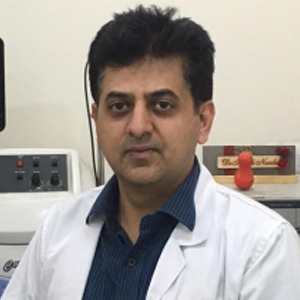
Dizziness is a complaint wherein the patient tries to describe the subjective disturbance in his or her orientation in space. Dizziness may signify one or more of the following sensations to the patient.
- Sensation of rotation.
- Sensation of faintness & impending unconsciousness.
- Disequilibrium.
- Light-headedness & weakness.
- Uneasiness, insecurity & confusion.
Vertigo & Deafness Clinic
Kataria Eye & ENT Hospital has an advanced vertigo clinic with facilities to diagnose all causes of vertigo
Special tests
Assessment and treatment of TINNITUS-a problem of ringing sounds in the ears. Tinnitus is a common but extremely troublesome problem. Tinnitus retraining therapy is conducted for suitable patients.
Neurotological Tests
- BERA Test – Brain Stem Evoked Response Audiometry is an objective test that gives us the approximate hearing threshold level of the subject. It is a very reliable test to objectively evaluate the hearing threshold of an adult or child across all frequencies except for the low frequencies. It is usually done using a click sound by which the subject’s average hearing threshold across all frequencies can be automatically assessed without the subject having to respond. This test can be used to assess hearing thresholds even in newborn babies.
- Pure Tone Audiometry – This is a subjective test in which the result is dependent on the patient’s response. It is considered to be the most informative test in the audio logical test battery and is a very reliable test if done by a reliable person. It gives an idea of the hearing threshold in the different frequencies. If there is deafness it tells us whether the deafness is due to defect in the middle ear or in the inner ear or in the nerve of hearing. Localizing tests like TDT, SISI, ABLB and glycerol tests which help in diagnosing the nature and site of lesion are also done here.
- High Frequency Audiometry – This special testing is done for patients of tinnitus, sudden hearing loss, hearing loss due to exposure to loud noise, industrial workers etc. We test frequencies from 250 – 16,000 Hz.
- Impedance Audiometry – Also called tympanometry, this test tells us about the functioning of the middle ear and also that of the cochlea (i.e. inner ear). This is an objective test (i.e. the results are not dependent upon the subject’s response) and it helps the clinician to identify the nature of pathology in middle ear disorders, like whether it is a case of Otosclerosis, Otitis Media with Effusion, adhesive otitis media etc.
Surgical treatment of vertigo:
Vertigo is often referred to as “incurable. It is important to know that in general the treatment of vertigo depends upon the treatment of the cause. The failure of treatment is often due to failure in identifying the cause.
Causes of Vertigo
BPPV – This condition manifests as sudden onset of vertigo when the patient goes to a particular position like turning to one side in bed. The vertigo lasts for less than a minute. It is a due to calcium carbonate crystals collecting to form larger particles which stimulate the nerve of balance. It can be easily treated by physical therapy in the form of Epley’smanoeuvre
Meniere’s disease is the commonest treatable cause of vertigo. This is a condition in which episodes of vertigo occur along with hearing loss and ringing in the ears. It is due to the increased fluid pressure within the inner ear. This condition can be controlled mostly by medicines though the treatment is essentially medical, surgery is indicated in certain selected cases which do not respond to medical therapy. It is sometimes better to undertake a step-wise approach to treat this benign but debilitating disease.
Medical Therapy is successful in 75% of cases.
Medical therapy is successful only 75% cases following failure of medical therapy, the first step is CHEMICAL LABYRINTHECTOMY, in which a small incision is made in the ear drum, a ventilation tube is inserted, and then medications poured down the tube until the desirable end point is reached. This is successful in about 75% of cases treated.
In rest of the patient’s refractory to all kinds of medical treatment, The option offered to the patient is ENDOLYMPHATIC SAC DECOMPRESSION. The postulated cause of Meniere’s disease is an increase in the endolymphatic pressure. Therefore in principle a procedure that releases the “pressure valve” of the inner ear would improve the patient’s symptoms. This is a simple operation, which, if done correctly, offers a good result to over 80% of the patients.
Finally, the last resort in the treatment of unilateral Meniere’s disease is MINIMALLY-INVASIVE RETROSIGMOID VESTIBULAR NERVE SECTION. In this the vestibular nerve is sectioned .This is the treatment of choice when the affected ear has no useful hearing, as it involves sacrifice of the hearing of that ear.




